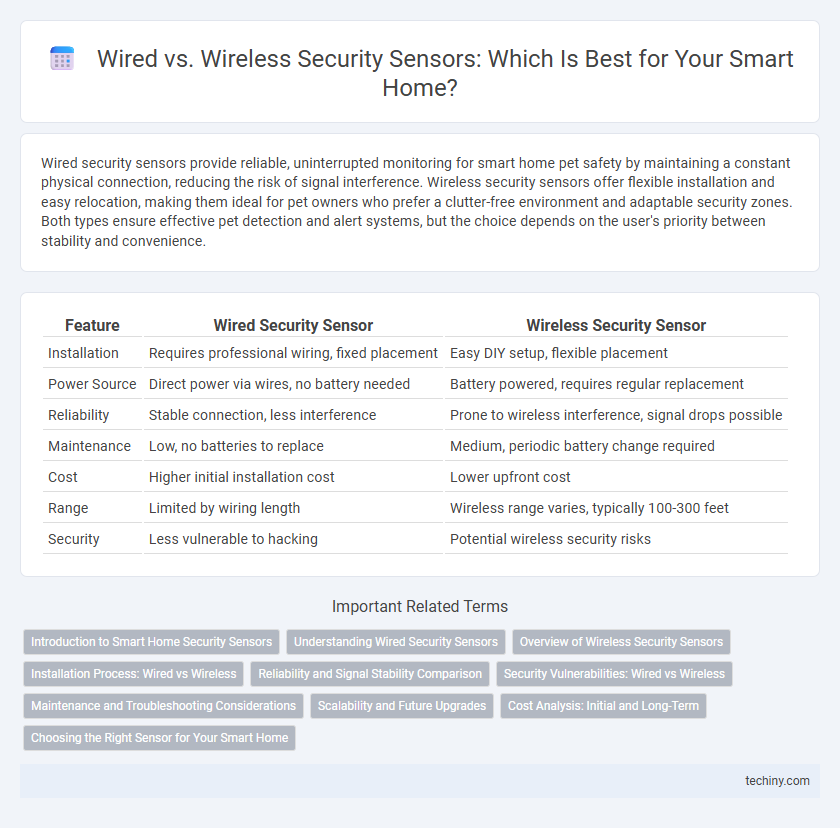Wired security sensors provide reliable, uninterrupted monitoring for smart home pet safety by maintaining a constant physical connection, reducing the risk of signal interference. Wireless security sensors offer flexible installation and easy relocation, making them ideal for pet owners who prefer a clutter-free environment and adaptable security zones. Both types ensure effective pet detection and alert systems, but the choice depends on the user's priority between stability and convenience.
Table of Comparison
| Feature | Wired Security Sensor | Wireless Security Sensor |
|---|---|---|
| Installation | Requires professional wiring, fixed placement | Easy DIY setup, flexible placement |
| Power Source | Direct power via wires, no battery needed | Battery powered, requires regular replacement |
| Reliability | Stable connection, less interference | Prone to wireless interference, signal drops possible |
| Maintenance | Low, no batteries to replace | Medium, periodic battery change required |
| Cost | Higher initial installation cost | Lower upfront cost |
| Range | Limited by wiring length | Wireless range varies, typically 100-300 feet |
| Security | Less vulnerable to hacking | Potential wireless security risks |
Introduction to Smart Home Security Sensors
Smart home security sensors play a crucial role in enhancing residential safety by detecting unauthorized access and environmental changes. Wired security sensors offer reliable connections through physical cables, minimizing interference and requiring less frequent maintenance, making them ideal for permanent installations. Wireless security sensors provide flexibility and easy installation with battery-powered operation, enabling seamless integration into existing smart home systems and remote monitoring capabilities.
Understanding Wired Security Sensors
Wired security sensors in smart home systems provide reliable and continuous connectivity by being physically connected to the central control panel, ensuring minimal interference and consistent power supply. These sensors are often favored for their enhanced security, as they are less vulnerable to hacking or signal jamming compared to wireless alternatives. Installation requires professional wiring work, which can increase upfront costs but offers long-term stability and reduced maintenance needs.
Overview of Wireless Security Sensors
Wireless security sensors use radio frequency signals to communicate with the central security system, eliminating the need for complex wiring and enabling flexible installation locations. These sensors typically operate on batteries and incorporate advanced encryption protocols to ensure secure, reliable transmission of alerts for intrusions, smoke, or environmental hazards. Their ease of integration with smart home hubs and mobile apps allows real-time monitoring and remote control, enhancing overall home security and convenience.
Installation Process: Wired vs Wireless
Wired security sensors require professional installation involving physical wiring through walls, which can be time-consuming and may cause structural disruption. Wireless security sensors offer a simpler installation process, using battery power and radio signals to communicate, allowing for quick setup without drilling or complex wiring. This makes wireless sensors ideal for renters or those seeking a hassle-free, flexible security solution.
Reliability and Signal Stability Comparison
Wired security sensors offer superior reliability with consistent power supply and minimal interference, ensuring stable signal transmission crucial for uninterrupted smart home security. Wireless security sensors provide greater installation flexibility but may experience signal degradation or interference from physical obstacles and other wireless devices, impacting reliability. Selecting between wired and wireless sensors depends on the priority of stable, uninterrupted monitoring versus ease of installation and system scalability.
Security Vulnerabilities: Wired vs Wireless
Wired security sensors offer enhanced protection against hacking and signal interference due to their direct physical connections, reducing vulnerabilities associated with wireless transmissions. Wireless security sensors are susceptible to jamming attacks, signal interception, and hacking risks because they rely on radio frequencies that can be intercepted or disrupted. Choosing wired sensors can significantly decrease the risk of unauthorized access, while wireless systems require robust encryption and frequent firmware updates to mitigate security vulnerabilities.
Maintenance and Troubleshooting Considerations
Wired security sensors require minimal maintenance but can involve complex troubleshooting due to physical wiring issues or damage. Wireless security sensors offer easier installation and reduced maintenance but may face interference, battery replacement, and connectivity troubleshooting. Choosing between wired and wireless sensors depends on balancing maintenance convenience against potential troubleshooting challenges in smart home security systems.
Scalability and Future Upgrades
Wired security sensors offer reliable connectivity with minimal interference but can be challenging to scale and upgrade due to fixed cabling and installation constraints. Wireless security sensors provide flexible scalability and easier integration with smart home systems, enabling seamless future upgrades without extensive rewiring. Advanced wireless sensors also support firmware updates over-the-air, ensuring ongoing enhancements and compatibility with evolving smart home technologies.
Cost Analysis: Initial and Long-Term
Wired security sensors typically involve higher initial installation costs due to complex wiring requirements and professional labor, but they offer lower long-term maintenance expenses thanks to fewer signal disruptions and no battery replacements. Wireless security sensors often present a lower upfront cost and easier installation, yet ongoing expenses such as battery replacements and potential signal interference can increase long-term maintenance costs. Evaluating total cost of ownership involves balancing these initial and operational expenses against reliability and scalability needs within smart home security systems.
Choosing the Right Sensor for Your Smart Home
Wired security sensors offer reliable, consistent connectivity and are less prone to interference, making them ideal for permanent installations with existing electrical infrastructure. Wireless security sensors provide greater flexibility and easier installation, suitable for retrofit projects or homes where drilling and wiring are impractical. Selecting the right sensor depends on your home's layout, installation complexity, and the need for scalability within your smart home security system.
Wired Security Sensor vs Wireless Security Sensor Infographic

 techiny.com
techiny.com